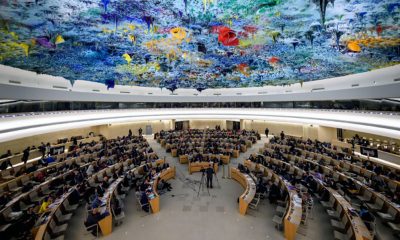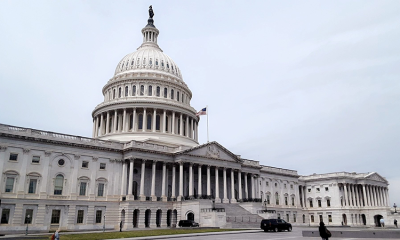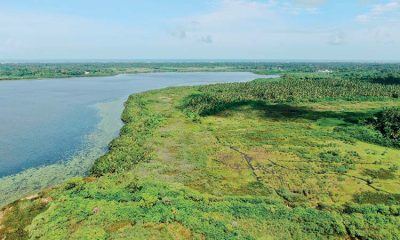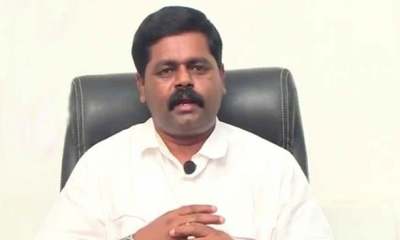Features
End of operations in Tissamaharama and postscript on the futility of war

Concluding installment
by Capt. FRAB Musafer,
4th Rgt. SLA (Retd.)
Tissamaharama was relatively peaceful with hardly any offensive insurgent activity. The police had regained their confidence and went about their normal duties. With operational commands being reorganized the gunners were deployed to Kurunegala. I was there for a few weeks before I had to leave to India for a Young Ofiicers’ gunnery course in India together with Lt Ballagalla. Incidentally we were the most senior officers on that course, the rest having just passed out of the Indian Military Academy.
Before I left Hambantota I dropped in to say goodbye to the GA, Mr Sonny Goonewardne, who thanked me for my services . He mentioned that a Sub Inspector Musafer was being posted to Hungama. He happened to be my cousin. Sadly on the day after my return from India, New Years day1972, I had to proceed to Middeniya to where he was transferred, to bring back his body which had been prepared for burial by the Muslim townsfolk.
Sharir, as he was known to us, had on the previous day had dinner with one of the older Rajapaksas and had appeared to be perfectly normal. His death has been shrouded in mystery as he was supposed to have committed suicide in the early hours of the morning having washed his face and turning a semi automatic weapon to his head. It was totally uncharacteristic of him as he was not the bravest of the brave. As to why he took his own life remains unanswered.
The aftermath
In summarizing the period of the operations in the Hambantota area it turned out to be a challenge under trying circumstances but a satisfying one nevertheless. The period from April 5 to about 10 was hectic being on my own and with no clear orders from above. There was some uncertainty but no panic.
There were no heroics or bravery to talk of. The platoon suffered no casualties (deaths). There were no police stations that were overrun, thanks to the bravery of the policemen. There were insurgents killed in these attacks but they were minimal. We were never fired upon and never had the opportunity to fire at the insurgents. It was a total anti-climax to the hype that prevailed.
This was a total contrast to the actions, risks and situations that my colleagues encountered in other areas. In some instances it was kill or be killed. It was surprising that the supposed hotbed and home of the insurgency had not showed the full face of its militant arm in this area. Was it due to the bungling of the date of the planned attack or the military presence in the area since mid March? If it was for the latter reason, it was mission accomplished.
The Town Council passed a resolution appreciating the Army for our services and the manner in which we conducted ourselves. The people of Hambantota had played their part in rejecting the JVP. An instance that comes to mind was during a gun amnesty, an old villager having walked for miles unable to afford his bus fare turned up at camp to surrender a very old unlicensed shot gun wrapped up in old newspapers. His voice trembling he said that he could not let the insurgents lay their hands on his gun. What a commitment! We were glad we had won the hearts and minds of Hambantota and its surroundings.
This was an insurgency that was very violent in other parts of the country and the death toll estimated was anyone’s guess, 5,000, 10,000? Sightings of dead bodies flowing down the rivers, charred and mutilated bodies in public places and bodies being set alight using tyres was widely circulated but never reported in the local press.
A strong press censorship was in place, under the emergency regulations. It is alleged that a large number of suspected insurgents were indiscriminately killed by the security forces. Locals suspected of collaborating with the security services were also killed by the JVP. There was this element of fear and self preservation that prevailed in areas where insurgent activity was dominant. False allegations and personal rivalries communicated to security personnel about bearded persons, local thugs and innocent youth had led to summary executions. Unfortunately it was evident that in such situations poor leadership and ” the beast in man” had overcome saner thinking and there had been blatant disregard for human life.
This was to be repeated in a more brutal way in the late 80’s as well. The casualties suffered by both sides in the 1971 insurgency was low in comparison to what happened in later years. I was not privy to the brutality that prevailed and was rampant in the late 1980’s having migrated to Australia in 1976 but believe it was estimated in the tens of thousands. It is said that ruthless waves of terror was unleashed by the government as well as the JVP.
The year 1971 was the first time the army encountered an armed insurrection and for a brief period of time the insurgents appeared to be successful but were thwarted by a resolute army, untrained and ill equipped to meet such situations but strong enough to counter- attack with the help of a determined government and cooperation of the international community. There were many incarcerated for long periods until pardoned who later transformed their lives.
The failure on the part of the insurgents was the lack of a proper leadership, a clear coordinated plan, poor communications, inadequate arms and ammunition and the absence of the promised support from those elements within the armed services and perhaps a foreign country and most importantly from the masses.
Post Insurgency
What happened in1971 was nothing compared to the protracted and brutal war of nearly 30 years where so many thousands died, both civilians and servicemen. These events changed the role of the army from a peace time and sometimes tainted as a ceremonial Army to a very dedicated, professional and well trained army exemplified by their actions in rescuing those fleeing the clutches of the LTTE in the final stages of the war .
It was their courage, dedication and commitment that triumphed to bring the war to an end. I would say this transformation was the same in the Navy and Air Force as well. As a former soldier I would like to pay tribute to all those service and police personnel who sacrificed their lives for a better tomorrow for all the people of Sri Lanka and express my regrets that so many innocent civilians also died in a conflict that took us nowhere and divided a nation. The country has gone through hell and changed so much for the worse in so many respects..
In 1965 when as an officer cadet, travelling by train to Diyatalawa a fellow passenger who was a surveyor based in Diyatalawa got into conversation with me and said that the Army was a waste of time and money. I replied that the Army was for the Internal security of the country and we had to train and be prepared for situations such as civil disturbances. Later events proved how wrong he was and ill-equipped the Army was.
I never imagined that our armed forces would have expanded so much but it was brought about by necessity at so much cost that eventually helped the country to get rid of one of the most dangerous and ruthless terrorist outfits in the world. Whilst we take pride in this achievement we should not forget the misery and hardships it brought about to our once peaceful and harmonious nation.
There was only one regiment of artillery with 12 artillery pieces of which only four were battleworthy, Today we have 12 regiments with an array of weapons ranging from multiple barrel rocket launchers, field guns and howitzers capable of firing at ranges of well over 15 kilometres.
Likewise every other arm of the Army has expanded. We now have tanks , armoured personnel carriers, commandos, paratroopers, special forces and more, whilst the Navy has offshore patrol vessels that ventured over hundreds of kilometres into international waters to destroy the LTTE supply ships; fast gunboats, fast missile vessels. fast attack craft, naval elite forces and a whole lot more. The Air Force is equipped with a range of fighter jets and strike aircraft, helicopter gunships and transport planes and more. The war also brought out the ingenuity of both sides of the conflict to improvise and build military, air and naval capacity to suit and counter each others strengths and weaknesses.
Never in my wildest dreams did I envisage that the country would be armed to this extent at such an enormous cost. Would we have acquired so much military hardware if we had no war? Perhaps not. It is now a question of maintaining all that we acquired.
In the 60s and 70s whilst on overseas courses we were subjected to the butt end of jokes as to the strength of our 8,000-strong army led by one major general then. But today we have so many major generals and one Lieut General as the commander and a force of around 200,000 plus personnel. It is an enormous cost that the country has to bear for generations to come and can ill afford.
The horrors of war and conflict
It was sad that so many thousands of lives were lost in all three conflicts and many innocent civilians caught in the middle paid the price for no fault of theirs. Their misery and sufferings continue and the scars of war will take a long time to heal. A culture of violence and corruption has eroded the moral fabric of society to the lowest depths. The human and economic cost was enormous and its ill effects thrust upon a nation .
Ask a front line soldier of the untold stories of courage, bravery, valour, cowardice, fear, hardships and the horrors of war endured by both sides of the conflict. The experiences of seeing their comrades dying beside them, killed or maimed. The sight and stench of mutilated, disfigured and rotting corpses of friend and foe in the battlefield, the carnage left by the heavy ground fighting often supported by aerial bombardment, land mines, tank and relentless artillery fire, paint a gruesome picture .
The sounds of ferocious automatic and machine gun fire that still ring in their ears will be hard to forget. These are shared experiences of those who have survived the war and hopefully realize the folly and futility of war and preach the gospel of peace and not revel and glorify war ever again.
“War is a dying business ” was a poster depicting a soldier leaping over a row of coffins draped with the US flag that I saw when the Sri Lanka Defence Services rugby team visited a US Marine living quarters in India when the Vietnam war was still raging. It was clear the sentiment of this poster was Anti-War. It is ironic that it is the soldier that detests war most and longs for peace. May this wish be the same for all Sri Lankans.
The leaders of our country together with the politicians and all the people at home and abroad must ensure that we learn from our mistakes and pursue and endeavour on a path that will deliver greater economic benefits to all the people in the island with the same commitment, zeal and tenacity with which the war was supported and fought by both sides.
Whilst the atrocities committed by both sides are hard to forget it is now a time to forgive and rebuild. Could not the billions of dollars raised and spent on this conflict have been better spent to achieve this end? There is so much poverty and hardship in the island that still needs to be addressed.
There are no winners in war This was exemplified when the Nigerian forces defeated the Biafran forces in a bitter three year civil war where more than a million people died, many from starvation. The victorious General Yakuza Gowan declared that there are ” No Victors and No Vanquished”. There were no medals awarded to commemorate the victory but only a hand of peace extended to bring about Reconciliation, Rehabilitation and Reconstruction which was most gracious and appropriate.
The reconciliation process in Nigeria was a shining light to the rest of the world way back in 1970. Sri Lanka could have followed that example but sadly opted for triumphalism instead. A golden opportunity of statesmanship to reconcile and rebuild the country was lost. The country’s leadership has since lacked the courage to make amends for its folly since the war ended 14 years ago.
“Oh, when will we ever learn”?
Capt F.R.A.B.Musafer 4th Regt SLA (Retd)
Ranks of the officers and other ranks mentioned were as serving ranks as of 1971.Many of the names mentioned have since passed away.
Features
The heart-friendly health minister
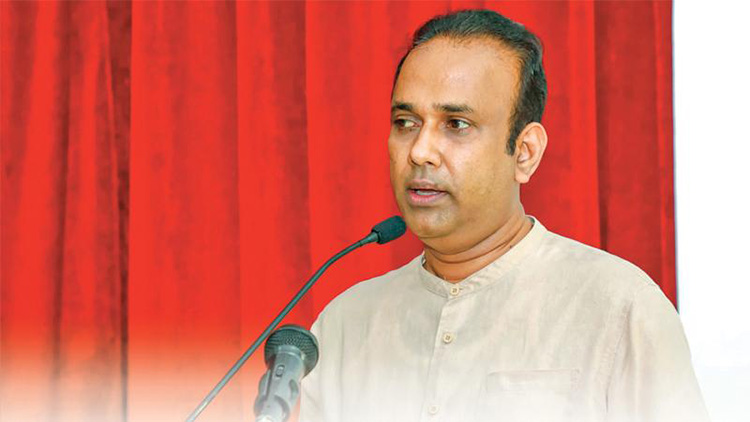
by Dr Gotabhya Ranasinghe
Senior Consultant Cardiologist
National Hospital Sri Lanka
When we sought a meeting with Hon Dr. Ramesh Pathirana, Minister of Health, he graciously cleared his busy schedule to accommodate us. Renowned for his attentive listening and deep understanding, Minister Pathirana is dedicated to advancing the health sector. His openness and transparency exemplify the qualities of an exemplary politician and minister.
Dr. Palitha Mahipala, the current Health Secretary, demonstrates both commendable enthusiasm and unwavering support. This combination of attributes makes him a highly compatible colleague for the esteemed Minister of Health.
Our discussion centered on a project that has been in the works for the past 30 years, one that no other minister had managed to advance.
Minister Pathirana, however, recognized the project’s significance and its potential to revolutionize care for heart patients.
The project involves the construction of a state-of-the-art facility at the premises of the National Hospital Colombo. The project’s location within the premises of the National Hospital underscores its importance and relevance to the healthcare infrastructure of the nation.
This facility will include a cardiology building and a tertiary care center, equipped with the latest technology to handle and treat all types of heart-related conditions and surgeries.
Securing funding was a major milestone for this initiative. Minister Pathirana successfully obtained approval for a $40 billion loan from the Asian Development Bank. With the funding in place, the foundation stone is scheduled to be laid in September this year, and construction will begin in January 2025.
This project guarantees a consistent and uninterrupted supply of stents and related medications for heart patients. As a result, patients will have timely access to essential medical supplies during their treatment and recovery. By securing these critical resources, the project aims to enhance patient outcomes, minimize treatment delays, and maintain the highest standards of cardiac care.
Upon its fruition, this monumental building will serve as a beacon of hope and healing, symbolizing the unwavering dedication to improving patient outcomes and fostering a healthier society.We anticipate a future marked by significant progress and positive outcomes in Sri Lanka’s cardiovascular treatment landscape within the foreseeable timeframe.
Features
A LOVING TRIBUTE TO JESUIT FR. ALOYSIUS PIERIS ON HIS 90th BIRTHDAY

by Fr. Emmanuel Fernando, OMI
Jesuit Fr. Aloysius Pieris (affectionately called Fr. Aloy) celebrated his 90th birthday on April 9, 2024 and I, as the editor of our Oblate Journal, THE MISSIONARY OBLATE had gone to press by that time. Immediately I decided to publish an article, appreciating the untiring selfless services he continues to offer for inter-Faith dialogue, the renewal of the Catholic Church, his concern for the poor and the suffering Sri Lankan masses and to me, the present writer.
It was in 1988, when I was appointed Director of the Oblate Scholastics at Ampitiya by the then Oblate Provincial Fr. Anselm Silva, that I came to know Fr. Aloy more closely. Knowing well his expertise in matters spiritual, theological, Indological and pastoral, and with the collaborative spirit of my companion-formators, our Oblate Scholastics were sent to Tulana, the Research and Encounter Centre, Kelaniya, of which he is the Founder-Director, for ‘exposure-programmes’ on matters spiritual, biblical, theological and pastoral. Some of these dimensions according to my view and that of my companion-formators, were not available at the National Seminary, Ampitiya.
Ever since that time, our Oblate formators/ accompaniers at the Oblate Scholasticate, Ampitiya , have continued to send our Oblate Scholastics to Tulana Centre for deepening their insights and convictions regarding matters needed to serve the people in today’s context. Fr. Aloy also had tried very enthusiastically with the Oblate team headed by Frs. Oswald Firth and Clement Waidyasekara to begin a Theologate, directed by the Religious Congregations in Sri Lanka, for the contextual formation/ accompaniment of their members. It should very well be a desired goal of the Leaders / Provincials of the Religious Congregations.
Besides being a formator/accompanier at the Oblate Scholasticate, I was entrusted also with the task of editing and publishing our Oblate journal, ‘The Missionary Oblate’. To maintain the quality of the journal I continue to depend on Fr. Aloy for his thought-provoking and stimulating articles on Biblical Spirituality, Biblical Theology and Ecclesiology. I am very grateful to him for his generous assistance. Of late, his writings on renewal of the Church, initiated by Pope St. John XX111 and continued by Pope Francis through the Synodal path, published in our Oblate journal, enable our readers to focus their attention also on the needed renewal in the Catholic Church in Sri Lanka. Fr. Aloy appreciated very much the Synodal path adopted by the Jesuit Pope Francis for the renewal of the Church, rooted very much on prayerful discernment. In my Religious and presbyteral life, Fr.Aloy continues to be my spiritual animator / guide and ongoing formator / acccompanier.
Fr. Aloysius Pieris, BA Hons (Lond), LPh (SHC, India), STL (PFT, Naples), PhD (SLU/VC), ThD (Tilburg), D.Ltt (KU), has been one of the eminent Asian theologians well recognized internationally and one who has lectured and held visiting chairs in many universities both in the West and in the East. Many members of Religious Congregations from Asian countries have benefited from his lectures and guidance in the East Asian Pastoral Institute (EAPI) in Manila, Philippines. He had been a Theologian consulted by the Federation of Asian Bishops’ Conferences for many years. During his professorship at the Gregorian University in Rome, he was called to be a member of a special group of advisers on other religions consulted by Pope Paul VI.
Fr. Aloy is the author of more than 30 books and well over 500 Research Papers. Some of his books and articles have been translated and published in several countries. Among those books, one can find the following: 1) The Genesis of an Asian Theology of Liberation (An Autobiographical Excursus on the Art of Theologising in Asia, 2) An Asian Theology of Liberation, 3) Providential Timeliness of Vatican 11 (a long-overdue halt to a scandalous millennium, 4) Give Vatican 11 a chance, 5) Leadership in the Church, 6) Relishing our faith in working for justice (Themes for study and discussion), 7) A Message meant mainly, not exclusively for Jesuits (Background information necessary for helping Francis renew the Church), 8) Lent in Lanka (Reflections and Resolutions, 9) Love meets wisdom (A Christian Experience of Buddhism, 10) Fire and Water 11) God’s Reign for God’s poor, 12) Our Unhiddden Agenda (How we Jesuits work, pray and form our men). He is also the Editor of two journals, Vagdevi, Journal of Religious Reflection and Dialogue, New Series.
Fr. Aloy has a BA in Pali and Sanskrit from the University of London and a Ph.D in Buddhist Philosophy from the University of Sri Lankan, Vidyodaya Campus. On Nov. 23, 2019, he was awarded the prestigious honorary Doctorate of Literature (D.Litt) by the Chancellor of the University of Kelaniya, the Most Venerable Welamitiyawe Dharmakirthi Sri Kusala Dhamma Thera.
Fr. Aloy continues to be a promoter of Gospel values and virtues. Justice as a constitutive dimension of love and social concern for the downtrodden masses are very much noted in his life and work. He had very much appreciated the commitment of the late Fr. Joseph (Joe) Fernando, the National Director of the Social and Economic Centre (SEDEC) for the poor.
In Sri Lanka, a few religious Congregations – the Good Shepherd Sisters, the Christian Brothers, the Marist Brothers and the Oblates – have invited him to animate their members especially during their Provincial Congresses, Chapters and International Conferences. The mainline Christian Churches also have sought his advice and followed his seminars. I, for one, regret very much, that the Sri Lankan authorities of the Catholic Church –today’s Hierarchy—- have not sought Fr.
Aloy’s expertise for the renewal of the Catholic Church in Sri Lanka and thus have not benefited from the immense store of wisdom and insight that he can offer to our local Church while the Sri Lankan bishops who governed the Catholic church in the immediate aftermath of the Second Vatican Council (Edmund Fernando OMI, Anthony de Saram, Leo Nanayakkara OSB, Frank Marcus Fernando, Paul Perera,) visited him and consulted him on many matters. Among the Tamil Bishops, Bishop Rayappu Joseph was keeping close contact with him and Bishop J. Deogupillai hosted him and his team visiting him after the horrible Black July massacre of Tamils.
Features
A fairy tale, success or debacle
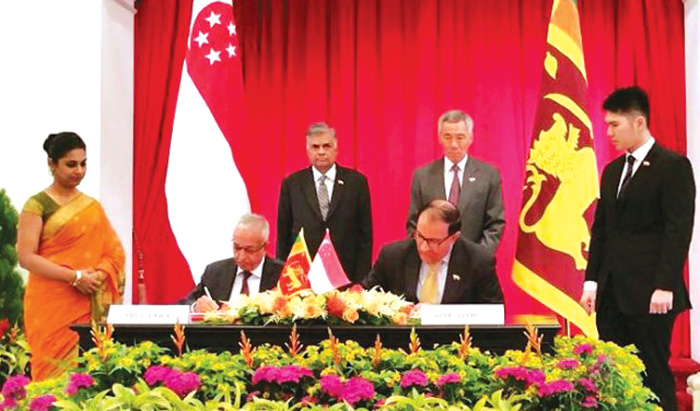
Sri Lanka-Singapore Free Trade Agreement
By Gomi Senadhira
senadhiragomi@gmail.com
“You might tell fairy tales, but the progress of a country cannot be achieved through such narratives. A country cannot be developed by making false promises. The country moved backward because of the electoral promises made by political parties throughout time. We have witnessed that the ultimate result of this is the country becoming bankrupt. Unfortunately, many segments of the population have not come to realize this yet.” – President Ranil Wickremesinghe, 2024 Budget speech
Any Sri Lankan would agree with the above words of President Wickremesinghe on the false promises our politicians and officials make and the fairy tales they narrate which bankrupted this country. So, to understand this, let’s look at one such fairy tale with lots of false promises; Ranil Wickremesinghe’s greatest achievement in the area of international trade and investment promotion during the Yahapalana period, Sri Lanka-Singapore Free Trade Agreement (SLSFTA).
It is appropriate and timely to do it now as Finance Minister Wickremesinghe has just presented to parliament a bill on the National Policy on Economic Transformation which includes the establishment of an Office for International Trade and the Sri Lanka Institute of Economics and International Trade.
Was SLSFTA a “Cleverly negotiated Free Trade Agreement” as stated by the (former) Minister of Development Strategies and International Trade Malik Samarawickrama during the Parliamentary Debate on the SLSFTA in July 2018, or a colossal blunder covered up with lies, false promises, and fairy tales? After SLSFTA was signed there were a number of fairy tales published on this agreement by the Ministry of Development Strategies and International, Institute of Policy Studies, and others.
However, for this article, I would like to limit my comments to the speech by Minister Samarawickrama during the Parliamentary Debate, and the two most important areas in the agreement which were covered up with lies, fairy tales, and false promises, namely: revenue loss for Sri Lanka and Investment from Singapore. On the other important area, “Waste products dumping” I do not want to comment here as I have written extensively on the issue.
1. The revenue loss
During the Parliamentary Debate in July 2018, Minister Samarawickrama stated “…. let me reiterate that this FTA with Singapore has been very cleverly negotiated by us…. The liberalisation programme under this FTA has been carefully designed to have the least impact on domestic industry and revenue collection. We have included all revenue sensitive items in the negative list of items which will not be subject to removal of tariff. Therefore, 97.8% revenue from Customs duty is protected. Our tariff liberalisation will take place over a period of 12-15 years! In fact, the revenue earned through tariffs on goods imported from Singapore last year was Rs. 35 billion.
The revenue loss for over the next 15 years due to the FTA is only Rs. 733 million– which when annualised, on average, is just Rs. 51 million. That is just 0.14% per year! So anyone who claims the Singapore FTA causes revenue loss to the Government cannot do basic arithmetic! Mr. Speaker, in conclusion, I call on my fellow members of this House – don’t mislead the public with baseless criticism that is not grounded in facts. Don’t look at petty politics and use these issues for your own political survival.”
I was surprised to read the minister’s speech because an article published in January 2018 in “The Straits Times“, based on information released by the Singaporean Negotiators stated, “…. With the FTA, tariff savings for Singapore exports are estimated to hit $10 million annually“.
As the annual tariff savings (that is the revenue loss for Sri Lanka) calculated by the Singaporean Negotiators, Singaporean $ 10 million (Sri Lankan rupees 1,200 million in 2018) was way above the rupees’ 733 million revenue loss for 15 years estimated by the Sri Lankan negotiators, it was clear to any observer that one of the parties to the agreement had not done the basic arithmetic!
Six years later, according to a report published by “The Morning” newspaper, speaking at the Committee on Public Finance (COPF) on 7th May 2024, Mr Samarawickrama’s chief trade negotiator K.J. Weerasinghehad had admitted “…. that forecasted revenue loss for the Government of Sri Lanka through the Singapore FTA is Rs. 450 million in 2023 and Rs. 1.3 billion in 2024.”
If these numbers are correct, as tariff liberalisation under the SLSFTA has just started, we will pass Rs 2 billion very soon. Then, the question is how Sri Lanka’s trade negotiators made such a colossal blunder. Didn’t they do their basic arithmetic? If they didn’t know how to do basic arithmetic they should have at least done their basic readings. For example, the headline of the article published in The Straits Times in January 2018 was “Singapore, Sri Lanka sign FTA, annual savings of $10m expected”.
Anyway, as Sri Lanka’s chief negotiator reiterated at the COPF meeting that “…. since 99% of the tariffs in Singapore have zero rates of duty, Sri Lanka has agreed on 80% tariff liberalisation over a period of 15 years while expecting Singapore investments to address the imbalance in trade,” let’s turn towards investment.
Investment from Singapore
In July 2018, speaking during the Parliamentary Debate on the FTA this is what Minister Malik Samarawickrama stated on investment from Singapore, “Already, thanks to this FTA, in just the past two-and-a-half months since the agreement came into effect we have received a proposal from Singapore for investment amounting to $ 14.8 billion in an oil refinery for export of petroleum products. In addition, we have proposals for a steel manufacturing plant for exports ($ 1 billion investment), flour milling plant ($ 50 million), sugar refinery ($ 200 million). This adds up to more than $ 16.05 billion in the pipeline on these projects alone.
And all of these projects will create thousands of more jobs for our people. In principle approval has already been granted by the BOI and the investors are awaiting the release of land the environmental approvals to commence the project.
I request the Opposition and those with vested interests to change their narrow-minded thinking and join us to develop our country. We must always look at what is best for the whole community, not just the few who may oppose. We owe it to our people to courageously take decisions that will change their lives for the better.”
According to the media report I quoted earlier, speaking at the Committee on Public Finance (COPF) Chief Negotiator Weerasinghe has admitted that Sri Lanka was not happy with overall Singapore investments that have come in the past few years in return for the trade liberalisation under the Singapore-Sri Lanka Free Trade Agreement. He has added that between 2021 and 2023 the total investment from Singapore had been around $162 million!
What happened to those projects worth $16 billion negotiated, thanks to the SLSFTA, in just the two-and-a-half months after the agreement came into effect and approved by the BOI? I do not know about the steel manufacturing plant for exports ($ 1 billion investment), flour milling plant ($ 50 million) and sugar refinery ($ 200 million).
However, story of the multibillion-dollar investment in the Petroleum Refinery unfolded in a manner that would qualify it as the best fairy tale with false promises presented by our politicians and the officials, prior to 2019 elections.
Though many Sri Lankans got to know, through the media which repeatedly highlighted a plethora of issues surrounding the project and the questionable credentials of the Singaporean investor, the construction work on the Mirrijiwela Oil Refinery along with the cement factory began on the24th of March 2019 with a bang and Minister Ranil Wickremesinghe and his ministers along with the foreign and local dignitaries laid the foundation stones.
That was few months before the 2019 Presidential elections. Inaugurating the construction work Prime Minister Ranil Wickremesinghe said the projects will create thousands of job opportunities in the area and surrounding districts.
The oil refinery, which was to be built over 200 acres of land, with the capacity to refine 200,000 barrels of crude oil per day, was to generate US$7 billion of exports and create 1,500 direct and 3,000 indirect jobs. The construction of the refinery was to be completed in 44 months. Four years later, in August 2023 the Cabinet of Ministers approved the proposal presented by President Ranil Wickremesinghe to cancel the agreement with the investors of the refinery as the project has not been implemented! Can they explain to the country how much money was wasted to produce that fairy tale?
It is obvious that the President, ministers, and officials had made huge blunders and had deliberately misled the public and the parliament on the revenue loss and potential investment from SLSFTA with fairy tales and false promises.
As the president himself said, a country cannot be developed by making false promises or with fairy tales and these false promises and fairy tales had bankrupted the country. “Unfortunately, many segments of the population have not come to realize this yet”.
(The writer, a specialist and an activist on trade and development issues . )


